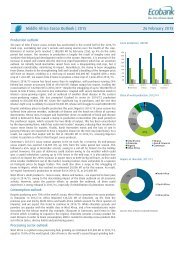www.ebook777.com
Make_Getting_Started_with_Processing_Second_Edition
Make_Getting_Started_with_Processing_Second_Edition
Create successful ePaper yourself
Turn your PDF publications into a flip-book with our unique Google optimized e-Paper software.
196 Getting Started with Processing<br />
<strong>www</strong>.<strong>ebook777.com</strong><br />
void draw() {<br />
if (port.available() > 0) { // If data is available,<br />
val = port.read(); // read it and store it in val<br />
val = map(val, 0, 255, 0, height); // Convert the value<br />
}<br />
rect(40, val-10, 360, 20);<br />
}<br />
The Serial library is imported on the first line and the serial port<br />
is opened in setup(). It may or may not be easy to get your Processing<br />
sketch to talk with the Arduino board; it depends on<br />
your hardware setup. There is often more than one device that<br />
the Processing sketch might try to communicate with. If the<br />
code doesn’t work the first time, read the comment in setup()<br />
carefully and follow the instructions.<br />
Within draw(), the value is brought into the program with the<br />
read() method of the Serial object. The program reads the data<br />
from the serial port only when a new byte is available. The<br />
available() method checks to see if a new byte is ready and<br />
returns the number of bytes available. This program is written<br />
so that a single new byte will be read each time through draw().<br />
The map() function converts the incoming value from its initial<br />
range from 0 to 255 to a range from 0 to the height of the<br />
screen; in this program, it’s from 0 to 220.<br />
Example 13-8: Visualizing the Data<br />
Stream<br />
Now that the data is coming through, we’ll visualize it in a more<br />
interesting format. The values coming in directly from a sensor<br />
are often erratic, and it’s useful to smooth them out by averaging<br />
them. Here, we present the raw signal from the light sensor<br />
illustrated in the top half of the example and the smoothed signal<br />
in the bottom half:



